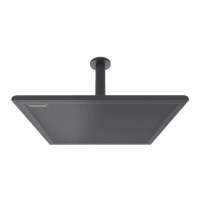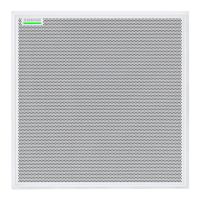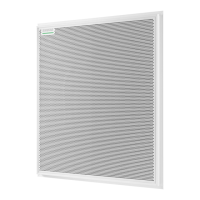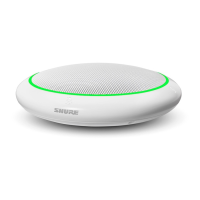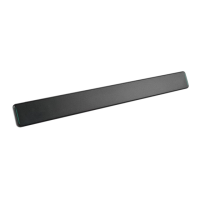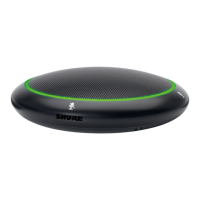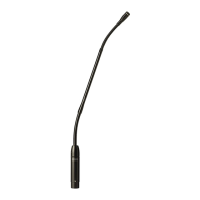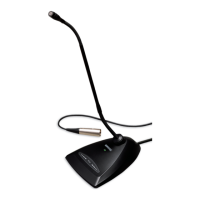Do you have a question about the Shure MXA910-60CM and is the answer not in the manual?
Provides a general description of the MXA910 Ceiling Array Microphone.
Details the microphone's configurable coverage, IntelliMix DSP, and software control.
Explains the system architecture, including Dante audio, power, and control.
Outlines changes and new features between firmware versions 3.x and 4.x.
Step-by-step guide for connecting the microphone to a network.
Instructions to locate and access the MXA910 using Shure Designer.
Guide to setting up coverage lobes and patterns within Designer.
Steps for enabling and configuring DSP features like AEC and noise reduction.
How to route audio signals from the MXA910 to other devices.
Details MXA910 compatibility with ANI22, ANIUSB, and P300.
Use cases for soft codec solutions with ANIUSB or P300.
Guidance for integrating the MXA910 with ANI22 and hard codecs.
Configuration for large rooms using multiple MXA910s with a P300.
Explanation of the Network Ethernet Port and LED indicators.
Details on the reset button and Power over Ethernet (PoE).
Guidelines for optimal microphone placement in various room conditions.
Details on installing the microphone in ceiling grids, including variations and protectors.
Covers suspension, VESA, and hard ceiling mounting options.
Information on cable management and the optional junction box accessory.
Using Designer for system configuration, coverage, and control.
Procedures for accessing the device's web-based GUI.
Steps for updating device firmware using the Shure Update Utility.
Details controls for coverage, channels, and system settings in Designer.
Configuring microphone lobes, position, and width for optimal coverage.
Adjusting gain levels, using the Parametric Equalizer (PEQ), and EQ contours.
Managing presets, mute/fader groups, and AES67 network configuration.
Explains automix channels, modes (Gating, Gain Sharing, Manual), and settings.
Details on Acoustic Echo Cancellation (AEC), Noise Reduction, AGC, Delay, Compressor.
Principles of Dante digital audio transport over Ethernet networks.
Best practices, IP configuration, latency settings, and QoS.
Overview of required TCP/UDP ports for control and Dante audio.
Solutions for issues like software lags, audio problems, and device discovery.
Safety, compliance, and usage guidelines for the microphone.
Details on lobe width, dimensions, power, temperature, and physical characteristics.
Includes output channels, DSP capabilities, intelligibility, polar response, and frequency response.
Lists optional accessories like junction boxes and furnished items like rubber pads.
Provides a general description of the MXA910 Ceiling Array Microphone.
Details the microphone's configurable coverage, IntelliMix DSP, and software control.
Explains the system architecture, including Dante audio, power, and control.
Outlines changes and new features between firmware versions 3.x and 4.x.
Step-by-step guide for connecting the microphone to a network.
Instructions to locate and access the MXA910 using Shure Designer.
Guide to setting up coverage lobes and patterns within Designer.
Steps for enabling and configuring DSP features like AEC and noise reduction.
How to route audio signals from the MXA910 to other devices.
Details MXA910 compatibility with ANI22, ANIUSB, and P300.
Use cases for soft codec solutions with ANIUSB or P300.
Guidance for integrating the MXA910 with ANI22 and hard codecs.
Configuration for large rooms using multiple MXA910s with a P300.
Explanation of the Network Ethernet Port and LED indicators.
Details on the reset button and Power over Ethernet (PoE).
Guidelines for optimal microphone placement in various room conditions.
Details on installing the microphone in ceiling grids, including variations and protectors.
Covers suspension, VESA, and hard ceiling mounting options.
Information on cable management and the optional junction box accessory.
Using Designer for system configuration, coverage, and control.
Procedures for accessing the device's web-based GUI.
Steps for updating device firmware using the Shure Update Utility.
Details controls for coverage, channels, and system settings in Designer.
Configuring microphone lobes, position, and width for optimal coverage.
Adjusting gain levels, using the Parametric Equalizer (PEQ), and EQ contours.
Managing presets, mute/fader groups, and AES67 network configuration.
Explains automix channels, modes (Gating, Gain Sharing, Manual), and settings.
Details on Acoustic Echo Cancellation (AEC), Noise Reduction, AGC, Delay, Compressor.
Principles of Dante digital audio transport over Ethernet networks.
Best practices, IP configuration, latency settings, and QoS.
Overview of required TCP/UDP ports for control and Dante audio.
Solutions for issues like software lags, audio problems, and device discovery.
Safety, compliance, and usage guidelines for the microphone.
Details on lobe width, dimensions, power, temperature, and physical characteristics.
Includes output channels, DSP capabilities, intelligibility, polar response, and frequency response.
Lists optional accessories like junction boxes and furnished items like rubber pads.
| Bit Depth | 24-bit |
|---|---|
| Sampling Rate | 48 kHz |
| Output Connector | RJ45 |
| Color | White |
| Microphone Type | Array |
| Form Factor | Ceiling |
| Polar Pattern | Steerable |
| Connectivity | Dante, Ethernet |
| Power Requirements | PoE (Power over Ethernet) |
| Dimensions | 60 cm x 60 cm |
